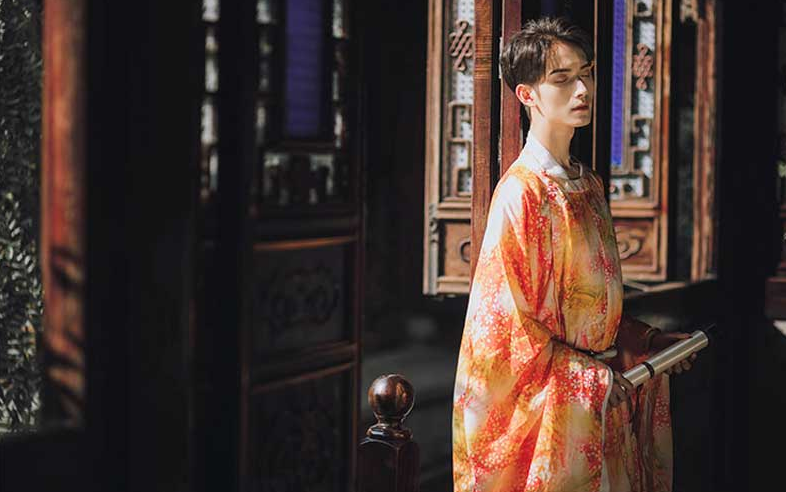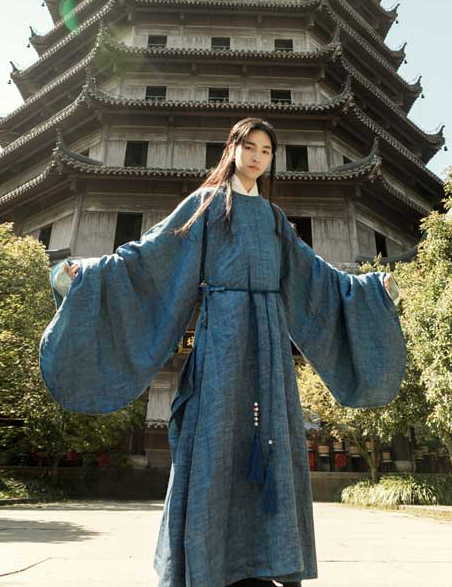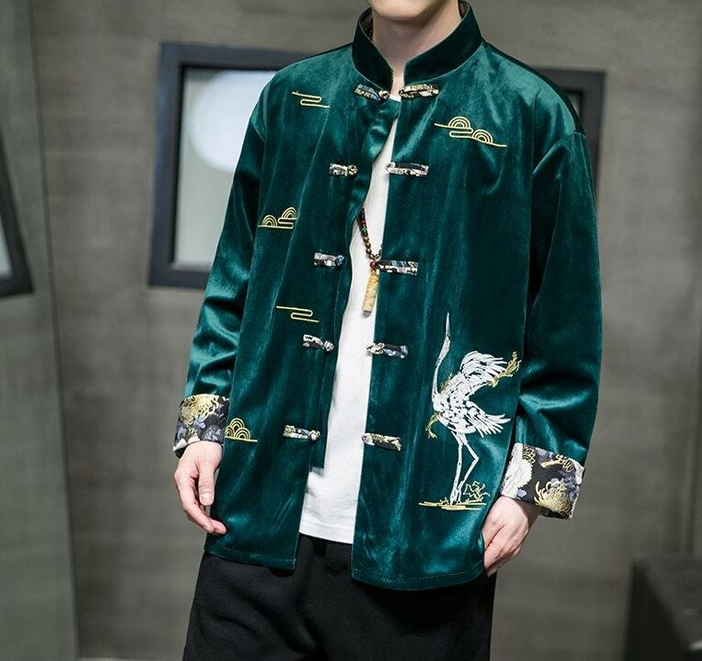The traditional Chinese clothing for men is called “Hanfu.”
Hanfu: The Han Chinese Clothing
Hanfu, deriving its name from the Han Dynasty, is a historical and cultural representation of the traditional dress worn by the Han Chinese, the ethnic majority of China. As centuries rolled by, Hanfu evolved in style and significance, and today, it stands as an emblem of Chinese identity and tradition.

Origins and Historical Background
The Hanfu has its roots dating back to over 4,000 years ago during the time of the Yellow Emperor. As dynasties changed, so did the style and essence of Hanfu, but its core elements remained consistent.
Key Components and Styles
Hanfu comprises several pieces, each with its own unique significance:
- Yi (衣): The open cross-collar garment, often tied with a sash.
- Pao (袍): Closed full-body garment, which became prevalent during the Ming Dynasty.
- Ru (襦): Open cross-collar shirt, typically worn underneath the Yi.
- Shan (衫): Front-buttoned shirt similar to the Ru but can be worn by itself.
- Ku (裤): Trousers or pants.
The length, colors, and materials of Hanfu varied depending on the occasion, social status, and season. For instance, silk, known for its fine quality and luxurious touch, was predominantly worn by royalty and the elite. On the other hand, commoners often wore Hanfu made from cotton or hemp.
In terms of colors, during the Han Dynasty, a deep shade of yellow was reserved for the emperor, signifying his close relation to the heavens. Other colors had their own meanings too, such as red symbolizing happiness and blue representing the heavens and the divine.
Modern Revival of Hanfu
In the 21st century, with globalization and cultural exchanges, there has been a resurgence in the popularity of Hanfu, especially among the younger generation. This modern revival can be attributed to a newfound sense of cultural pride and identity. Fashion designers are innovating with the traditional styles, incorporating modern aesthetics while retaining the essence of Hanfu. With its growing presence in media, film, and popular culture, Hanfu has become not just a relic of the past, but a vibrant part of China’s contemporary fashion scene. Many enthusiasts join Hanfu groups, participate in cultural events, and even host fashion shows, celebrating the rich tapestry of their heritage.
Changshan: The Long Shirt or Robe
The Changshan, translated as “long shirt” or “robe,” is a traditional dress worn by Chinese men, especially recognized for its iconic design during the Qing Dynasty. This attire not only represented Chinese fashion but also depicted the socio-cultural shifts happening in China during its tumultuous history.
The Influence of the Qing Dynasty
The Qing Dynasty, the last imperial dynasty of China, played a significant role in the popularization of the Changshan. This period saw the Manchu ethnic group rise to power, bringing with them the Manchu male dress. Over time, this Manchu attire began to merge with the Han Chinese fashion, leading to what we recognize today as the Changshan.
Historically, Changshan was an attire signifying one’s status and position. It was during the Qing Dynasty, specifically in the late 19th and early 20th centuries, that the Changshan underwent significant transformations, adapting more practical and diverse styles. The influence of Western fashion and the socio-political changes, particularly after the Boxer Rebellion, were pivotal in shaping the Changshan’s evolution during this era.
Distinct Features and Variations
The Changshan typically extends to the heel and has a high mandarin collar, also known as a stand-up collar. Some defining features include:
- Buttons and Loops: Unlike the typical Western buttons, Changshan uses fabric knotted buttons and loops, especially on the upper part of the shirt.
- Material: While the affluent often adorned silk Changshans with intricate embroidery, those with more modest means would wear cotton or linen variants. The quality of silk used could drastically affect the price, with premium silk Changshans costing over 1,500 Yuan.
- Slits: Traditionally, Changshans have slits on both sides to facilitate movement, especially since it’s a full-length robe.
In terms of variations, while the basic structure remained the same, Changshans came in different colors, materials, and patterns, each telling a story or representing a particular symbolic meaning.
Usage in Special Occasions
The Changshan is not just a daily wear garment; it has its esteemed place in Chinese special occasions. It is commonly worn during traditional Chinese festivals, weddings, and ceremonies. The color and design of the Changshan chosen for such events usually carry a deeper meaning. For instance, red, a symbol of luck and prosperity in Chinese culture, is a popular choice for wedding Changshans.
Moreover, during significant events like the Chinese New Year, it’s a common sight to see men wearing Changshans, revisiting their roots and paying homage to their ancestors. These occasions also often dictate the quality and design intricacy of the robe, with more elaborate designs signifying grander celebrations.
Magua: The Traditional Jacket
The Magua, an emblematic Chinese jacket, has been worn by men across various dynasties, each iteration reflecting the zeitgeist of its era. A fusion of functionality and style, the Magua has left an indelible mark on the annals of Chinese fashion.
Design and Materials
Magua jackets are typically short, reaching just below the waist or slightly longer. Here are some distinct design elements:
- Collar: Unlike the raised collar seen in Changshans, the Magua often has a flat, rounded collar.
- Closures: It features a series of knotted buttons or loops, often asymmetrically aligned to the right side.
- Sleeves: While the early versions had broader sleeves, modern adaptations might offer a more fitted look.
When it comes to materials, choices have varied based on region, climate, and economic status. The affluent classes, especially during the Ming and Qing dynasties, gravitated towards silk because of its rich texture and sheen. Detailed embroideries, often showcasing dragons, phoenixes, or nature scenes, would adorn these silk Maguas. On the other hand, the common masses often opted for durable materials like cotton or hemp. The intricacy of the embroidery and the quality of the material could significantly influence the price, with top-tier silk Maguas fetching upwards of 1,200 Yuan.
Occasions for Wearing Magua
Traditionally, the Magua was a staple for everyday wear. However, as styles evolved, and with the influx of western clothing post the Qing Dynasty, the Magua found its place primarily in formal and ceremonial events.
- Weddings: Grooms might don a specially crafted Magua with intricate patterns symbolizing longevity, prosperity, and a blissful marital union.
- Festivals: During certain festivals, particularly those honoring ancestors or deities, the Magua serves as an attire that bridges the contemporary with the historical.
While not as commonly worn today, there’s been a resurgence in its popularity, especially in events emphasizing traditional values or celebrating Chinese heritage.

Influence on Other Cultures
The Magua, with its unique design and cultural significance, has not remained confined to China. Its influence can be seen in neighboring countries:
- Korea: The Magua inspired the traditional Korean jacket known as “Jeogori.” While there are differences in design, the essence remains reminiscent of the Magua.
- Japan: Elements of the Magua can be observed in certain traditional Japanese attire, particularly in the way the jackets close and the nature of the knotted buttons.
Moreover, with the global spread of Chinese cinema, especially period dramas and Kung Fu movies, the Magua has gained recognition on the international stage. Today, fashion designers from various parts of the world have occasionally integrated Magua-inspired elements, celebrating the fusion of East and West.
Round-Collared Robe: The Ming Dynasty Influence
Embodied with elegance and tradition, the round-collared robe is a classic representation of Chinese sartorial history. Its profound influence during the Ming Dynasty carved its prominent place in the annals of Chinese fashion, serving as both everyday wear and ceremonial attire.
Historical Background
Originating during the early periods of Chinese history, the round-collared robe reached its zenith of popularity during the Ming Dynasty. This era, known for its prosperity and cultural advancements, saw a resurgence
in traditional Han Chinese clothing styles, as a stark contrast to the preceding Yuan Dynasty’s Mongol influences.
During the Ming era, the round-collared robe became synonymous with elegance and was a reflection of one’s status and refinement. Scholars, officials, and the noble class wore it as a mark of their stature and education. Moreover, this period witnessed the proliferation of textile industries, leading to innovations in fabric quality and design, further enhancing the robe’s aesthetic and cultural appeal.
Design and Patterns
The round-collared robe’s defining feature, as the name suggests, is its rounded collar, offering a sleek and sophisticated silhouette. Other distinct elements include:
- Closure: The robe typically closes at the right side, using intricate fabric knotted buttons and loops, a signature design in many traditional Chinese garments.
- Material: Silk, given its superior quality and sheen, was the primary material for these robes, especially among the elite. Patterns embroidered with gold or silver threads added to the robe’s opulence, making them high-value items. A premium quality robe with detailed embroidery could cost as much as 1,800 Yuan during the Ming era, equivalent to several months’ salary for a mid-level official.
- Patterns: Dragons, phoenixes, cranes, and floral motifs dominated the robe’s designs. The choice of pattern was often symbolic, with dragons representing imperial power and cranes symbolizing longevity.
Modern-day Usage and Influence
While the round-collared robe might not be a staple in everyday contemporary Chinese fashion, its influence is undeniable. Modern fashion designers often draw inspiration from the robe’s design, integrating its elements into haute couture collections. Moreover:
- Cultural Events & Festivals: The robe makes a comeback during festivals and cultural events, especially those that celebrate Chinese history and traditions.
- Film & Television: Historical dramas set in the Ming era often showcase characters adorned in round-collared robes, highlighting their historical accuracy and attention to detail.
- Global Influence: Fashion hubs like Paris, Milan, and New York have seen designs influenced by the round-collared robe, particularly during shows with an oriental theme or inspiration.

Footwear and Accessories
Chinese attire’s splendor doesn’t stop at garments. Footwear and accessories play an equally pivotal role in completing the traditional ensemble. Rooted in history, function, and symbolism, these additions are more than just ornamental; they convey status, identity, and cultural nuances.
Traditional Chinese Shoes for Men
Chinese traditional shoes have unique characteristics that set them apart from Western styles:
- Cloth Shoes: Predominantly made of cotton or silk, these shoes often come with intricate embroidery. Their soles, crafted from multiple layers of cloth, provided both comfort and insulation.
- Boots: Leather boots, predominantly worn in Northern China due to colder climates, were a sign of nobility and stature.
- Straw Sandals: Primarily for the working class, especially farmers, these were woven from straw, providing breathability during hot months.
Black was a common color, but for special occasions or for the elite, colors like red or gold were prevalent. Pricing varied drastically, from a mere 10 Yuan for basic straw sandals to upwards of 500 Yuan for high-quality silk shoes with intricate embroidery.
Hats and Headpieces
Hats were not just for protection against the elements but were also a sign of rank and status:
- Official’s Hat: Worn by bureaucrats, these hats often had wing-like flaps and denoted rank with specific decorations like peacock feathers or clear beads.
- Conical Hats: Often associated with farmers, these wide-brimmed bamboo or straw hats protected against sun and rain.
- Fur Caps: Popular during winter, especially in Northern regions, these caps provided warmth and were often adorned with jade or gold for the affluent.
A symbol of stature, an official’s hat during the Ming or Qing dynasty could be a significant investment, sometimes costing as much as 300 Yuan, a sum that could feed a small family for months.
Belts and Decorative Accessories
Belts and additional accessories were the finishing touches to traditional attire:
- Jade Belts: Predominantly worn by royalty and the affluent, these belts were adorned with jade pieces, symbolizing purity and moral integrity.
- Sash: Commonly used to secure robes like the Hanfu or Changshan, sashes were often made of silk and came in vibrant colors.
- Pendants & Brooches: Made from jade, gold, silver, or other precious stones, these were often symbolic, representing blessings, longevity, or protection.
Jade accessories, due to their cultural significance and material value, were among the pricier items. A well-crafted jade pendant could fetch a price of up to 2,000 Yuan during imperial times, making it a luxury few could afford.
The Influence of Traditional Clothing on Modern Fashion
China’s illustrious fashion history has not remained isolated within its borders. Over time, the rich tapestry of its traditional attire has woven its way into modern fashion, both within China and across the globe.
The Fusion of Western and Traditional Styles
The intersection of Western and Chinese fashion elements has birthed a unique style, harmonizing the best of both worlds:
- Silhouette Adaptations: Modern dresses and blouses often incorporate the classic high collars from traditional outfits, blending them with contemporary cuts and fabrics.
- Fabric Fusion: While silk remains a staple, designers are experimenting by combining it with more modern materials like denim, leather, or synthetic blends.
- Motifs and Embroidery: Patterns like dragons, phoenixes, and florals from traditional Chinese clothing now adorn everything from haute couture gowns to everyday wear tees.
Interestingly, while a modern dress with traditional embroidery could range from 500 to 1,500 Yuan, designer pieces combining high-quality materials with intricate patterns can demand prices upwards of 10,000 Yuan.

Popularization in Modern Media and Pop Culture
The global entertainment industry has played a pivotal role in propelling Chinese fashion:
- Film: Movies set in historic periods showcase traditional attire, while contemporary films often blend Western and Chinese styles, reflecting the cultural melting pot of modern China.
- Music: Popular artists, both in C-pop and global music scenes, incorporate Chinese fashion elements in their music videos and stage outfits.
- Fashion Shows: Top designers frequently infuse their collections with traditional motifs, making them runway successes and setting global fashion trends.
This media exposure not only popularizes the style but also educates global audiences about Chinese culture and history.
The Global Impact of Chinese Men’s Fashion
Chinese men’s fashion, historically rich and varied, has garnered international attention in recent decades:
- Global Brands: Major brands, aiming to cater to the expansive Chinese market, often release collections that integrate Chinese elements, especially around occasions like the Lunar New Year.
- Street Fashion: Elements like the Mandarin collar or the knotted buttons have found their way into global street fashion, popularized by influencers and fashion enthusiasts.
- Cultural Exchanges: Exhibitions, workshops, and fashion exchange programs often focus on the richness of Chinese men’s fashion, inspiring designers from around the world.